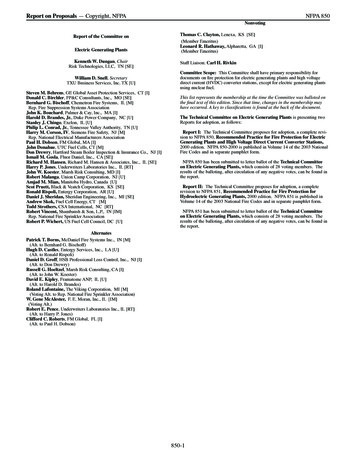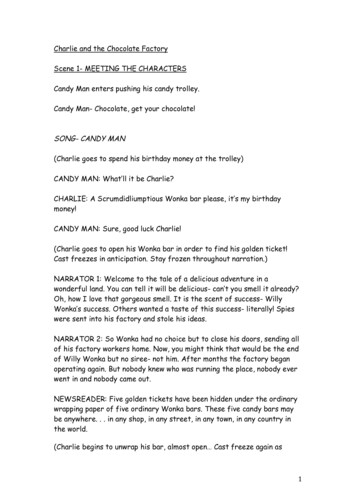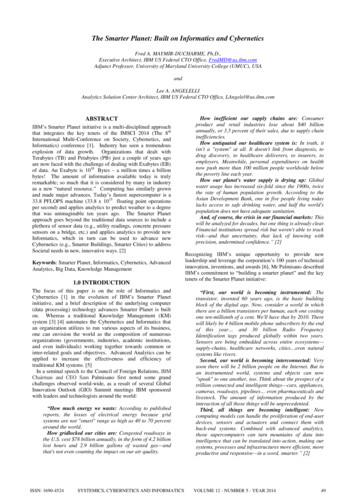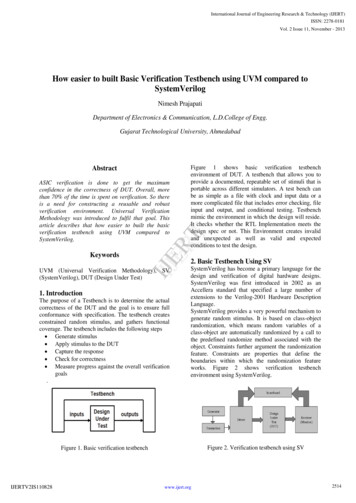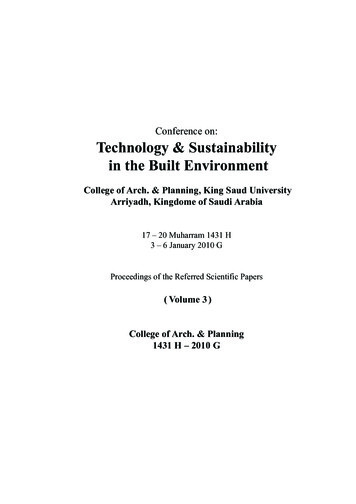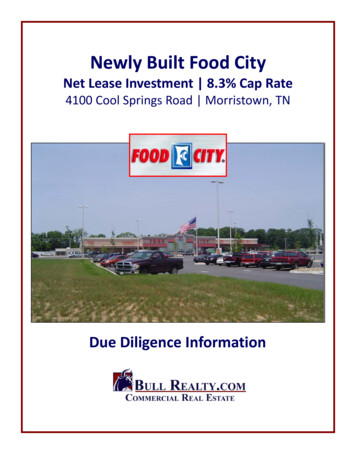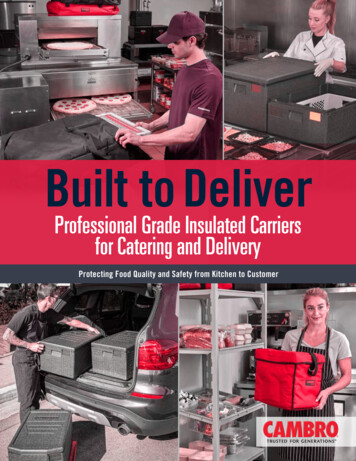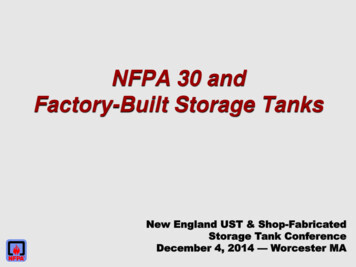
Transcription
NFPA 30 andFactory-Built Storage TanksNew England UST & Shop-FabricatedStorage Tank ConferenceDecember 4, 2014 — Worcester MA
Topics Covered organization of NFPA 30provisions for ALL storage tanksprovisions for ASTsprovisions for USTschanges in 2015 edition
NFPA 30 Organization2003 & earlier1-3 Administrative4 Tank Storage5 Piping6 ContainerStorage7 Operations8 Electrical2008 & later1-4 Administrative5-8 General Reqts.9-16 Container Storage17-20 Operations21-26 Tank Storage27 Piping28 Bulk Transfer
Bulk Storage Tanks1-4 Administrative5-8 General Reqts.9-16 Container Stge.17-20 Operations21-26 Tank Storage27 Piping28 Bulk Transfer21 Reqts. - All Tanks22 ASTs23 USTs24 Storage TankBldgs.25 Vaults
Scope of NFPA 30 applies to storage, handling, usedoes not apply to materials with melting point 100 F liquefied gases cryogenic fluids motor fuel dispensing transportation
Retroactivity (1.4) NFPA 30 does not apply retroactively,unless the authority having jurisdictiondetermines that a distinct hazardexists and must be rectified
Equivalency (1.5) NFPA 30 does not prevent the use ofsystems, methods, or devices ofequivalent or superior quality,effectiveness, or safety equivalency must be demonstrated
Definitions (Chapter 3) approvedauthority having jurisdictionimportant buildingprotection for exposuresproperty line “that is or can be built upon”
Applicability of General Chapters Chapter 4 covers definition andclassification of liquidsChapter 6 covers methodologies usedto identify, evaluate, and control fireand explosion hazardsChapter 7 covers electrical systemsand electrical area classification
Chapter 21 scope covers fixed tanks that exceed 60 gallons intermodal tanks and IBCs thatexceed 793 gallons capacityconnected to fixed pipingdoes not cover process tanks
Chapter 21 basic requirementsmaterials of constructiondesign and construction standardsprovisions for normal ventingcorrosion protectiontesting requirementsoperating requirementsinspection & maintenance
Chapter 21 some provisions include: combustible materials ofconstruction permitted under certainconditions maximum operating pressures forambient pressure tanks AST cannot be used underground UST cannot be used aboveground
Section 21.4.3 vent must prevent vacuum or pressurethat: can distort the roof can exceed the design pressuresize vent perAPI 2000 orother approvedstandard
Section 21.4.3.8 &.9 vent termination devices
Section 21.4.5 protection from internal corrosion additional metal thickness approved protective coatings or linings1.15
Section 21.5 testing requirements all tanks must be tested beforebeing placed in service per tankdesign standard
Section 21.5.2 tightness test Section 21.5.2 spells out in detail for tank & for interstitial space2015: if tank shipped with interstitialvacuum and vacuum is maintained, notightness test required
Section 21.7.1 overfill prevention procedures/systems required for all tanks 1,320 gal.storing Class I or Class II liquids aboveground tanks receiving /transferring Class I liquids frompipelines or marine vessels musthave written procedures reference API Standard 2350 reference EPA rules
Section 21.7.2 identification of tank contents NFPA 704 placardingsecurity is now an issue fencing
Chapter 22 Scope: Aboveground TanksNFPA 30 focuses on passive protection proper design and installation adequate emergency venting proper siting with respect toneighboring property spill control
Section 22.4 location (siting) of aboveground tanks separation distance from nearest important building near and far sides of public way property line that is or can be built upon shell-to-shell spacing
Section 22.4 factors that determine separation type of tank floating roof weak roof-to-shell seam horizontal or vertical withemergency relief vents* protection for the tank itself protection for exposed property*based on maximum 2.5 psioverpressure
Section 22.4LiquidTable(s)Class I, II, IIIA stable liquids(up to 2.5 psi)Class I, II, IIIA stable liquids( 2.5 psi)22.4.1.1(a) & 22.4.1.1(b)liquids w/ boil-over characteristicsunstable liquidsClass IIIB stable liquids22.4.1.422.4.1.5 & 22.4.1.1(b)22.4.1.622.4.1.3 & 22.4.1.1(b)
Table 22.4.1.1(a)Minimum DistanceTank Typefloating roofvertical withweak roof-toshell seamProtectionProperty Linefor exposed property½ DiameterNoneDiameter, 175’ maxapproved foam or inertgas system (150’ max)Important Bldg1/6Diameter½ Diameter1/6Diameterfor exposed property1 X Diameter1/3DiameterNone2 X Diameter(350’ max)1/Diameter3tanks withemergencyrelief venting,2.5 psi maxapproved foam or inertgas system (150” max)½ X Table 22.4.1.1(b)for exposed property1 X Table 22.4.1.1(b)none2 X Table 22.4.1.1(b)protectednone½ Table 22.4.1.1(b)
Table 22.4.1.1 (b)Capacity, galProperty Line, ftImportant Bldg. orPublic Way ft (m) 27555276 – 750105751 – 12,00015512,001 – 30,00020530,001 – 50,000301050,001 – 100,0005015100,001 – 500,0008025500,001 – 1,000,000100351,000,001 – 2,000,000135452,000,001 – 3,000,00016555 3,000,00017560
1243Table 22.4.2.1Table 22.4.2.1 — Shell to Shell SpacingDiameter, ft. 150 150 w/remoteimpoundingopen dikeFloating Roof Tanks1/61/61/4 adjacent diametersFixed Roof & HorizontalClass I /IIClass IIIA1/6 adjacent diameters adjacent diameters1/4 AD1/6 AD adjacent diameters1/3 AD1/4 ADIn no case is the separation allowed to be less than 3 ft.
Section 22.5 tank supports and foundation minimize excessive loading atsupports & minimize uneven settling design for earthquakes supports: masonry, concrete or steel
Section 22.7Emergency relief venting:A means to automaticallyrelieve excess pressureinside a tank due toexposure from anexternal fire.Not intended for pressurerelief from internalexplosion oroverpressure.
Section 22.7 emergency relief venting tanks must have additional ventingcapacity to prevent the tank fromexceeding 2.5 psig if exposed to fire can use floating roof, lifter roof,weak roof-to-shell seam, loose-boltcover, or emergency venting device
Section 22.7 Exception: tank storing Class IIIBliquids that: exceeds 12,000 gallons is not located within the same dikedarea or drainage path of tanks storingClass I or Class II liquids
Section 22.11 spill control – tanks holding Class I, II,or IIIA liquids must have means toprevent accidental release fromendangering important facilities,adjoining property, and waterways remote impounding diking combination of remoteimpounding and diking secondary containment-type tank
Remote Impounding100,000 gal50 ft min50 ftmin1% slopefor 50 ft100,000 gal
Impounding by Diking
Section 22.11 spill control – diking 1% slope from tank to dike wall dike capacity the greatest volumeof liquid that can be released fromthe largest tank (overflow point) local or state law might requiremore capacity!
Section 22.11 secondary containment-type tank prior to 2015 Class I:12,000 gallons Classes II & IIIA:20,000 gallons 2015 edition 50,000 gallons spacing per w/ Table 22.4.2.1
Chapter 23 scope covers buried tanks, i.e. backfilled
Chapter 23 basic requirements excavation external corrosion protection siting w/ respect to structures andproperty lines 3 ft for Class I liquid 1 ft for Classes II and III liquids bedding, burial depth, and backfill
Section 4.2.2
Bedding & Backfill (23.5) noncorrosive and inert compacted pea gravel or sandbedding depth per manufacturerbedding to extend 12” beyond footprint of tankbackfill to depth of 12” above tank greater if required by manufactureradditional cover: 12” of clean earth or 4” reinforced concrete
Vent Sizes (23.6)
NFPA 30A Scope: retail motor fuel dispensing facilities fleet motor fuel dispensing facilities marine motor fuel dispensing facilities repair garages
NFPA 30A storage of fuels and other liquids USTs per NFPA 30, Chapter 23 ASTs per NFPA 30, Chapter 22 andspecial siting requirements of 30Apiping systemsfuel dispensing systemselectrical systemsoperating requirementsvapor processing/collection systems
NFPA 30A special provisions for marine fuelingspecial provisions for gaseous fuels CNG, LNP, LPG, hydrogenspecial provisions for farms and remotesites
Table 4.3.2.4
Other Applications NFPA 31 governs fuel oil tanks foroil burning appliances indoor tanks outdoor tanks up to 660 gallonsNFPA 31 governs indoor fuel tanks forstationary engines and turbines generator sets fire pumps
Questions?
Contact InformationBob BenedettiTelephone: 617-984-7433617-571-8494 (cell) Telefax:617-984-7110 E-Mail:bbenedetti@nfpa.org
NFPA 30 and Factory-Built Storage Tanks New England UST & Shop-Fabricated Storage Tank Conference December 4, 2014 —Worcester MA. Topics Covered organization of NFPA 30 provisions for ALL storage tanks provisions for ASTs provisions for USTs changes in 2015 edition. NFPA 30 Organization 2003 & earlier 1-3 Administrative 4 Tank Storage 5 Piping 6 Container Storage 7
